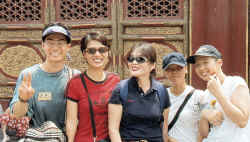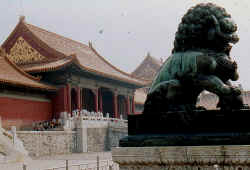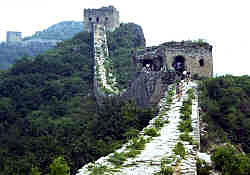BEIJING
Harlan Hague
Officials of the International Olympic Committee were in Beijing recently to review that city’s bid for the 2008 summer Olympic games. Beijing has an uphill battle to win the games. Opponents cite China’s human rights record and infrastructure problems. Beijing has another problem. The summer games are held in summer.
I visited
Beijing in summer. It was hotter than the seven brass hinges of hell, more humid than
Houston, and the air pollution was the worse I have seen anywhere on the globe. It was
like breathing under water. I showered three times daily. Now that I’ve got that off
my chest, I must add that the visit was most satisfying.
This was my first visit to China, and I got a taste early of what the English-only members of the groups that I organize and lead to Europe must feel when they try to communicate with Europeans. However, most Europeans that travelers encounter speak or understand some English. Not so in China. Shopkeepers and taxi drivers typically speak no English. At the front desk at my hotel, which caters to foreign tours, a basic question, like “should I leave my key here when I go out?”--a document in the room said that one should--was received with an embarrassed blank stare. After a huddle with four other clerks, the answer was a polite “no”.
I had heard that Chinese students like to practice their English with visitors. I had hardly stepped into Tiananmen Square when I was approached by a beginning college student who stayed with me for the next hour. He told me a bit about the square and commented on the exhibits in the adjacent Chinese Revolution History Museum as we strolled through. Afterwards we sat on the steps of the Museum, eating popsicles, and he ruined the encounter by asking for "help" with lunch money and bus fare, an amount that would have taken him halfway to Shanghai. Do what I did not do. Tell the student that you would enjoy talking, but that you don’t need a guide.
My spirits were lifted later when two young girls in white
dresses and sun hats approached me. They said hello,
asked if I was enjoying my  visit to Beijing, and could they take my picture. We talked a
few minutes, and they quickly exhausted their store of English. Each had her picture made
with me, they said goodbye and left, chattering. In the Forbidden City, I had a pleasant
conversation with five cheerful Korean college students who were on holiday. Later in the
Wangfujing shopping district, I felt like a visiting dignitary when a whole class of seven
or eight year old children crowded around me to say hello, how-are-you, it-is-hot, and
Michael Jordan. Their teacher shooed them away, then stayed to talk.
visit to Beijing, and could they take my picture. We talked a
few minutes, and they quickly exhausted their store of English. Each had her picture made
with me, they said goodbye and left, chattering. In the Forbidden City, I had a pleasant
conversation with five cheerful Korean college students who were on holiday. Later in the
Wangfujing shopping district, I felt like a visiting dignitary when a whole class of seven
or eight year old children crowded around me to say hello, how-are-you, it-is-hot, and
Michael Jordan. Their teacher shooed them away, then stayed to talk.
The Chinese are confident in their English. Remember those instructions for the made-in-China VCR? I had hardly left the Wangfujing conversation when a man walked by wearing a T-shirt bearing a large picture of a basketball and the words, "MAERICAN BASKETBALL". English captions on exhibits, and even brass tablets fixed to the walls of structures in the Forbidden City and elsewhere, often are riddled with misspellings and incorrect grammar.
The unpleasant weather did not prevent me and tens of thousands of others, mostly Chinese, from visiting the attractions of Beijing. The Forbidden City, officially the Palace Museum, was crowded with tourists. Originally built in the early fifteenth century, the complex was home and seat of government to emperors. It was not open to the public. Any citizen who strayed inside the walls of the city was subject to death. The public was invited inside in 1949 following the successful communist revolution.
Enter at the south entrance. Don’t stop at the kiosk labeled "Tickets for Foreigners" near Tiananmen Gate. It lies. I stood in line and was waved off by the clerk. Keep walking north, looking to the right for the ticket office. The Y85 price (Y8.30=US$l at this writing) includes the rental of cassette player and tape in English for the self-guided tour. It’s worth the price. They will ask for a non-monetary security deposit which is returned at the check-in point at the north gate. I left my California driver’s license.
 The buildings of the Forbidden City, mostly faithful
eighteenth and nineteenth century restorations and reconstructions, evoke a
civilization unfamiliar to most westerners. Spend the better part of a day here, stopping
the audio tape often to visit secondary structures not described by the narrator.
Don’t try to see them all; there are 800 buildings here.
The buildings of the Forbidden City, mostly faithful
eighteenth and nineteenth century restorations and reconstructions, evoke a
civilization unfamiliar to most westerners. Spend the better part of a day here, stopping
the audio tape often to visit secondary structures not described by the narrator.
Don’t try to see them all; there are 800 buildings here.
South of the Forbidden City--a brisk walk or short taxi ride--and associated with it in imperial history, is Tiantan Park. Here the emperor each year presided over ceremonies that were meant to influence the fortunes of the coming year. The rites particularly focused on supplications for good harvests. Enter at the south entrance and visit the three principal structures: the marble three-tiered Round Alter; the Imperial Vault of Heaven; and finally the magnificent Hall of Prayer for Good Harvests, whose image is seen all over Beijing.
The park is the best place to see taiji (tai chi). Arrive between, say, 6:00 a.m. and 7:30 a.m. to see Beijingers perform this gentle, fascinating combination of dance, exercise, and meditation. Admission to the park is Y.50. I mistakenly offered Y5. and the clerk accepted it. It was the only time in Beijing that I was ripped off. The all-inclusive Y30 tourist ticket includes admission to all attractions in the park. There is an acoustic guide, but I did not learn of it until halfway through my visit so cannot comment on its worth.
The Natural History Museum is immediately west of Tiantan Park and can be conveniently visited in conjunction with the park. The museum contains a good dinosaur exhibit and the usual halls of local flora and fauna. Visitors, Chinese and foreign alike, are fascinated with the pickled human cadavers that are cut open to show internal structure and organs. Admission Y10.
The Lama Temple, smaller than the Forbidden City and not so crowded with visitors, is equally interesting. The temple entrance is around the corner and a short walk from the Yonghegong subway station. The temple is laid out as a wide corridor which contains three elaborate archways and five principal halls that house statues of Buddha in his various aspects. Formal gardens surround the structures. The buildings and interiors, of different size and style, show a distinct Tibetan influence. The temple in the mid-eighteenth century was designated as a lamasery and was administered by Tibetan monks. Most of the monks today are Mongolian. Admission Y10, a real bargain.
No one should leave Beijing without walking on the Great Wall. Three sites are accessible from the city. Most visitors see the wall at Badaling, about forty-two miles northwest of the capital. This is the carefully reconstructed part of the wall with guard rails that one sees so often in pictures of China. It is the closest, most commercialized, comparatively expensive, and invariably crowded.
I opted for Simatai. Of the three sites that can be visited, this section of the wall is the most isolated, least restored, most romantic, and, I found to my dismay, the most difficult. When I stepped down from the bus, I looked around and saw no wall. I followed the gaze of my co-passengers, and saw it. The wall ran on the ridge line of a high mountain range a few miles away. My spirits sank.
"Pas de problème," said a French woman from the bus. "There is a cable lift." I did not discover until near the top of the lift that it covered only about two-thirds of the distance to the wall. The last third was a trail of switchbacks up a slope that must have approached forty-five degrees.
After an exhausting climb, I reached the top and was
rewarded with a magnificent view of the wall snaking down the mountainside and up and over
the range beyond. With the cable lift at my back, I faced what had been enemy
territory: Mongolia. The wall here has no rails and is very steep and slippery in places.
As I climbed down from the wall, a party of French young people were moving their gear
into a watchtower where they would spend the night.
range beyond. With the cable lift at my back, I faced what had been enemy
territory: Mongolia. The wall here has no rails and is very steep and slippery in places.
As I climbed down from the wall, a party of French young people were moving their gear
into a watchtower where they would spend the night.
The best place for independent travelers to visit the Great Wall is at Mutianyu. It is a compromise in all respects between the two other sites. It is closer and less difficult than Simatai, less crowded and developed than Badaling. There is a cable car. It is about fifty-four miles from Beijing.
The Summer Palace is another rewarding excursion from the city. Here in the hills and gardens, around a lake and in temples and pavilions, the imperial court escaped the heat of the city. Today citizens and tourists can visit the Hall of Benevolence & Longevity, Precious Clouds Pavilion, and Temple of the Sea of Wisdom. One can also stroll, or do whatever one does, in the Garden of Harmonious Pleasure. There is no way to escape crowds at the Summer Palace, but go on a weekday anyway. Or in February, if you can avoid frostbite.
Beijing has a reputation for being expensive, but it need
not be. My hotel, the Qianmen Hotel, is conveniently located and priced at about $75.00
for a single, including tax. One can dine well and inexpensively. My dinners from the a la
carte menu at the Qianmen Hotel averaged $6-8. A sumptuous buffet breakfast was about $4.
Even a half duck and side dishes at the famous Qianmen Quanjude Roast Duck Restaurant was
only $11. Expect to be discriminated against when buying admission tickets for
attractions. Prices for foreigners are many times the price for Chinese. It’s
official policy to milk the tourist cow.
Transportation is reasonable. The subway is a flat Y2. My typical taxi ride cost Y10.40, little more than $1. Look for the yellow taxis that have a Y1.00 sign in the back window. For a bit more comfort and air conditioning, opt for the taxi with a Y1.60 sign. The Y2.00 taxis are more upscale, but they typically do not have meters, and you must bargain for the rate. I find that annoying. Avoid the pedicabs altogether. I offered a pedicab driver Y10 to take me to a restaurant, a distance that would have cost Y10.40 by taxi. He demanded Y30 and stalked away when I declined.
I was baffled a number of times when taxi drivers refused to take me to a named destination. It must have something to do with the one-way street system or their concern that they might not find a return fare. One driver, after first refusing to take me to my hotel, about two miles away, relented and motioned me to get in. For the next twenty minutes, he drove through deep Beijing, through twisting narrow lanes of a residential district where food and wares of all sorts were offered for sale on the pavement at the edge of the roadway and people sat in front of their houses, talking, fanning, playing card games, trying to escape the heat. The drive was most interesting. Finally arriving at the hotel, the meter showed Y10.40. I offered the driver Y15 since the route had been long and difficult. He returned Y5 and pointed to the meter.
Tip: always take a good map, with both English and Chinese place names. Also ask a hotel clerk to write the name of your destination in Chinese characters. You’ll often need to show these to taxi drivers and others from whom you request directions.
Some guide books suggest that biking is a good way to see Beijing. Good luck. I wouldn’t advise it unless you have a death wish. Bicyclists and pedestrians mix with moving vehicles as if they had the right of way. They do not. The westerners that I saw riding bicycles did not look confident. One woman was stranded in the middle of fast-moving cars and trucks that missed her by inches. She was laughing hysterically. She’s probably there yet.
Buy the Lonely Planet Beijing guide, the only reference you’ll need. By the way, if you must travel in summer, go to Norway. Save Beijing for October.
Caveat: this article was published some time ago. Prices and other data may not be correct. Investigate before traveling.
If you have comments or questions, write to the author.